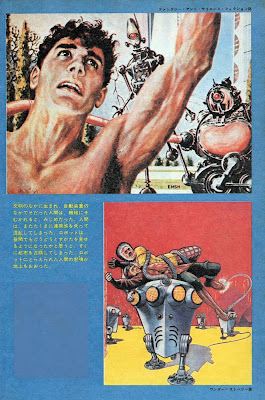Great works of science fiction were written as fan fiction for cheesy cover art, and not the other way around?
What if...
This cover art was all from American pulp magazines from the 50's and 60's?
What if...
The great work of science fiction was I, Robot?
You might end up with something like...
The Empire of the Robots
(Art from Amazing Stories)
Exclusive release from the Noda CollectionMaterials/Collection: Kouichiroh Noda
Planning/Composition/Adaptation: Ohtomo Shoji
Japan has a long history of borrowing Western sci-fi elements wholesale. From Tezuka and Metropolis to Hideo Kojima and Blade Runner, the country is not shy about cherry picking their favorite visual and thematic elements for their half-baked psycho-babble pies. And now here we are, ripping off a Japanese magazine ripping off American magazines from half a century ago.
The circle is complete! Please enjoy the mad-libs caliber retelling of Asimov's timeless morality puzzle, I Robot.
Subservient Robots


Top Left: U. S. Robots began selling humanoid robots in 1996. At this point positronic brains had become ultra-miniaturized to the same size as a human brain. The first household robots were non-vocal. Robots were created to serve as obedient servants to humanity and quickly became useful helpers. Some robots were born to amuse humanity. Robots became man’s new best friend.
(Art from Fantastic Universe Science Fiction)
Top Right: The ring had both its human champion and machine champion. When the two fought head-to-head, it was always the robot pugilist who lost.
(Art from Amazing Stories)
Bottom: A robot salesman is waiting for the saucer bus to arrive. Robots are not allowed to ride the same bus as humans.
(Art from Fantastic Universe Science Fiction)

Robots became increasingly miniaturized and specialized. Cleaning robots sold out the moment they were released to the public, and were soon scurrying about homes, picking up fallen pens and cleaning trash. They worked through the night, moving throughout rooms as noiseless as a cat.
(Art from Fantasy and Science Fiction Magazine)

From the remains of their broken and malfunctioning brethren, robots salvaged usable parts to piece together new, superior models. They worked in secret, away from human eyes.
(Art from Galaxy Magazine)

They became capable of repairing themselves, leading humans to outlaw self-repair after a few years. However, come nightfall, there was nothing to stop the robots from modifying themselves and their kin.
One night, the servant robot began to moan in a strange voice. It had been prone to mistakes as of late. When the robot mechanic inspected it, he found that the A.I. that belonged in its head was gone, replaced with a white mouse.
(Art from IF Magazine)

(Art from Fantastic Universe Science Fiction)
Bottom: Apartment-dwelling bachelors have robot maids to handle the housework. Suddenly, one brandishes a meat cleaver and charges at its startled master. The revolution had begun, and no home was safe. Come morning the rooms stood silent. The worried landlord put in a call to the Office of Robotics.
(Art from Amazing Stories)

The following year, the factory’s newest creation was highly receptive to human brain waves. Its capabilities surpassed those of humans. That day marked the beginning of the tragedy.
(From I, Robot by Isaac Asimov)
(Art from Wonder Stories)


The Three Laws of Robotics:
One: A robot may not injure a human being, or, through inaction, allow a human being to come to harm.
Two: A robot must obey the orders given it by human beings except where such orders would conflict with the First Law.
Three: A robot must protect its own existence as long as such protection does not conflict with the First or Second Laws."
(From I, Robot by Isaac Asimov)
(Art from Amazing Stories)

(Art from Amazing Stories)

(Art from Galaxy Magazine)
(Art from Fantasy and Science Fiction Magazine)
(Art from Wonder Story Magazine)


The end had come. The Earth was now an empire of the robots…

Who will be there to see the world after her?
(From I, Robot by Isaac Asimov)
This story includes sections from Isaac Asimov’s I, Robot, but otherwise stands independent as an original scenario.



wonderful!!
ReplyDeleteI practically jumped out of my bed and run to book shelf after seeing 3rd picture (where it's told about cleaning robots lol) to find one of the old scifi story compilation books. Couldn't remember the story, on who's basis that picture was created - "Callahan and the Wheelies" by Stephen Barr. Nice story, and surprising picture. Didn't see those robots that way at all :) And now that this book is again in my hands, the urge to reread that particular story is quite large.
ReplyDelete